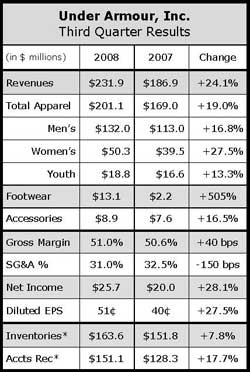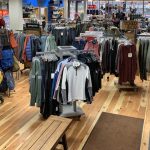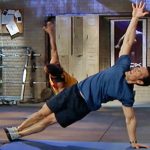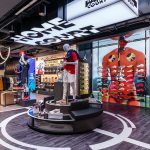Under Armour reported a 28.1% hike in third quarter earnings on a 24.1% revenue gain, slightly ahead of Wall Street’s expectations. But the performance apparel leader lowered its fiscal 2008 outlook due to the souring economic climate.
The company now anticipates FY08 revenues of $750 million to $765 million, representing 24% to 26% growth over 2007. That compares to a previous forecast calling for revenues between $765 million to $775 million. The lower guidance primarily reflects lower growth assumptions for apparel. Men’s apparel is now expected to grow in the mid-teens for the year, while women’s and youth are expected to grow in the mid-20s. FY08 income from operations is now expected to range between $97.5 million and $104.5 million, an increase of 13% to 21% over 2007, but down from the previous projected range of $104.5 million to $105.5 million.

On a conference call with analysts, management said it adjusted its view downward due to weakening replenishment trends, booking percentages and some cancellations over the last few weeks. The order cautiousness partly reflects economic worries but also a lack of cold weather, which is a key driver of the companys Cold Gear line.
FY08 gross margins projections have also been trimmed back to be 49.5% versus the prior outlook of 50%, based on Q308 gross margins. Part of the lower guidance reflects lower-than-expected revenues from the direct-to-consumer business as a result of order processing issues. Those issues have since been resolved. Direct to consumer, which carries a much-higher margin than the overall business, is expected to make up 14% to 15% of sales this year.
In the third quarter, apparel revenues increased 19.0% overall. Men’s apparel increased 16.8%, women’s grew 27.5% and kids was up 13.3%. Footwear revenues catapulted to $13.1 million from $2.2 million, mainly fueled by the launch of performance trainers. Average selling prices grew for both footwear and apparel in the quarter.
Gross margins increased 40 basis points although the year-ago margin rate was impacted by reserves and allowances related to discontinued footwear. The 150 basis point reduction in SG&A expenses was primarily due to a marketing expense decrease to 10.7% of sales from 11.5% a year ago. Under Armour still expects marketing expenses to be at the high end of its 12% to 13% range for the year.
Inventory, up 8% at the quarter’s end, continues to be a major focus for the company, and inventory growth is expected to be below sales growth at year-end. The company’s 25 outlet stores have been instrumental in keeping inventory levels in check.
Asked whether management sees the possibility of the environment turning worse, company COO Wayne Marino said UA is “pretty comfortable” in reaching its revised guidance. He was also encouraged that the brand continues to outperform at retail.
Chairman and CEO Kevin Plank spent a considerable amount of time discussing the brand’s launch into running footwear in Spring 2009. He noted the success Under Armour has had in reinvigorating and raising prices as theyve entered the cleated and training footwear categories. But he also mentioned that running, a $4.7 billion category, is a much bigger opportunity at nearly four to five times the size of training, its largest footwear category to date.
Plank noted that the running line has been “received tremendously” by retailers that have seen it. On-site fittings and tryouts at its sponsored Baltimore Marathon also delivered “great” feedback from consumers.
Regarding distribution, Plank said the line will be launched at the “roughly 700 or so” doors already selling Under Armour apparel. He said the line will “hopefully give a shot in the arm” to its core big box sporting goods chains as well as its new mall partners, Foot Locker and The Finish Line. But he also said having running footwear will help the brand expand in running specialty. He noted that some running specialty stores, mentioning Luke’s Locker in Dallas, have been reluctant to stock an apparel-only brand.
“This isnt something which is just [a] big box story,” said Plank. “The best specialty players out there, the mom and pops, believe in giving our brand a shot.”
Asked about any plans to enter soccer footwear given its efforts around European growth, Plank said the company has no plans so far.
“Not unlike basketball, I think the product and product readiness will dictate the timing of when we enter the categories,” commented Plank.















